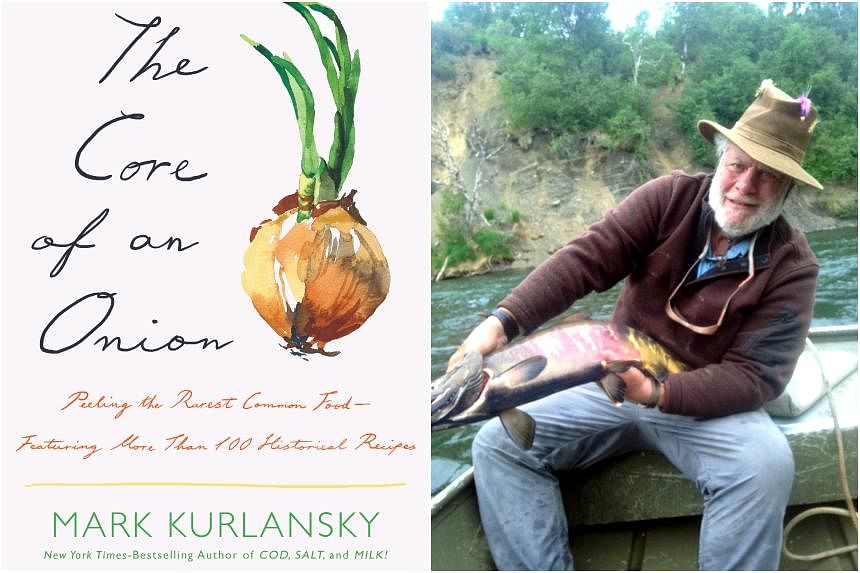The Core Of An Onion
By Mark Kurlansky
Bloomsbury Publishing/Hardcover/226 pages/$33.71/Amazon SG (amzn.to/3wV9cig)
3 stars
Whether you like Mark Kurlansky’s latest book depends on which of his previous food-themed tomes you prefer.
If you enjoyed the narrative-driven Cod: A Biography Of The Fish That Changed The World and Salmon, then this is not for you as, like this reviewer, you would be expecting a deep dive into a vegetable that plays a central role in practically all the cuisines of note around the world.
As Kurlansky notes in his introduction, “in much of the world, from Asia to the Mediterranean, the first step in cooking is often to chop an onion and have a good cry”.
Like the titular subject, this book lacks a strong core. The very universality of this humble bulb seems to have confounded the veteran American author, who has penned everything from non-fiction to children’s books.
So he takes a more scattershot approach of compiling random factoids about this plant which has been used both as a herb and a vegetable.
The book is divided into two parts. The first, The World According To Onions, collates facts about the onion itself, from An Extraordinary Lily, which explains the botanical and chemical elements of the bulb, to The Americas Know Their Onions, which traces its agricultural history.
In the second part, How To Eat An Onion, chapters are very loosely organised on the various ways the onion has been cooked in communities around the world throughout history.
This is the section where most of “more than 100 historical recipes” trumpeted on the book cover can be found. Do not expect detailed recipes, however, as most of the historic recipes are written in period fashion which presupposes knowledge of cooking methods and fail to provide quantities and timings.
Once you give up on the notion of a strong narrative, this book remains a diverting read, especially for trivia buffs and culinary nerds.
At his best, Kurlansky has the ability to distil his research and reading into concise paragraphs.
His explanation of why onions make you cry, for example, is a model of pop-science writing that combines clarity with accessibility: “The toxic spittle the vengeful onion sends into your eyes is low-molecular-weight substances with sulfur atoms… The molecules dissolve into the water of the eyes and turn into sulfuric acid, a nasty little trick designed for defense.”
The various compounds in the onion that gives it its strong smell and makes you cry also turns out to be the chemical elements that, when reacting with heat, can become “more than fifty times sweeter than table sugar”. Hence onions have traditionally been used to lend sweetness to savoury dishes through a variety of cooking methods.
The latter is explored in the second half, which reproduces culinary advice from writers such as Isabella Beeton, the famed Victorian authoress whose Mrs Beeton’s Book Of Household Management was the go-to for British housewives in the 19th century, and Fannie Farmer, her American counterpart.
The recipes are, as expected, dominated by European texts with some traditional dishes such as blood and onions and creamed onions which have mostly fallen out of favour with modern palates.
While there is a nod to the centrality of onions in Indian cuisine, there are just three short recipes for fried onion, bhajiya and pakora before Kurlansky returns to more familiar European territory. South-east Asian cuisine gets part of a one-liner in the fried onion context, “where they are sometime served with fried rice”.
The “sometime” also points to some slipshod editing. One recipe for a tart reads “Pour it into the pasta” where it should obviously read “Pour it into the pastry shell”.
Still, fans of Kurlansky’s more trivia-based books like Salt: A World History and Milk!: A 10,000-Year Food Fracas will forgive the lapses here as there are plenty of factoids to engage their curiosity.
If you like this, read: Cod: A Biography Of The Fish That Changed The World by Mark Kurlansky (Penguin Books, 1998, $11.29, Amazon SG, go to amzn.to/3TRW3j9). This book is a lively, engaging history of the fish and how it shaped communities ranging from the Vikings to the Basques to Newfoundland.


